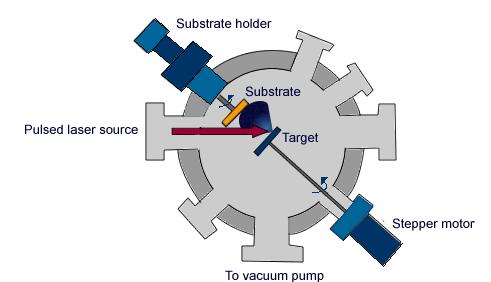A variety of target materials, including high-temperature superconductors, ferroelectrics, metals, polymers, and ceramics, can be deposited at room temperature using the vacuum-based PVD thin film coating technology known as pulsed laser deposition (PLD), which is dependable but very expensive.
Although the experimental setup is straightforward (see below), the actual ablation process is very intricate and involves interactions between the laser and solid targets, plasma generation, and material transport through the vacuum to the substrate.
In simplest terms, a rotating target is focussed by a powerful laser inside of a vacuum chamber. The small target surface area of the concentrated beam absorbs the intense energy of the beam, breaking down chemical bonds inside the targeted area. As a result, an ablation “plume” made up of a few target surface layers is ejected. The ions, electrons, atoms, radicals, or clusters that make up these layers move through the vacuum chamber at incredibly high speeds until they collide with the rotating substrate’s surface. Due to particle collisions inside the plume and interactions with the laser, the properties and composition of the plume may change in this brief period of time. The particles adhere to the substrate surface with a surprisingly high adhesion when the ablated material strikes it at high impact energy (usually 100 eV), and they are compacted to form a continuous film. More material is removed by subsequent laser pulses, and the film eventually thickens from a few atomic layers to microns. During the deposition phase, further surface modification operations like implantation or sputtering can occur. PLD films are not as dense as those created by other atom-by-atom deposition processes like magnetron sputtering.

